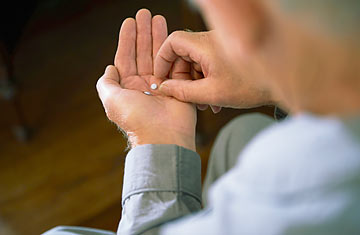
Ecstasy has always been an unusual drug of abuse. Its high is complicated: there is euphoria, certainly, and an amphetamine kick. But because ecstasy causes the brain to flood with serotonin and oxytocin — two chemicals heavily implicated in emotion — it has the atypical ability to precipitate both introspection and sociability. Despite the dreadful, serotonin-depleted ecstasy hangovers known as "suicide Tuesdays," users have for many years promoted the drug's salutary features. Still, are we ready for ecstasy to be thought of as medicine?
On July 19, the Journal of Psychopharmacology reported the results of the first randomized, controlled trial of ecstasy, which is known to chemists as 3,4-methylenedioxymethamphetamine, or MDMA. The study's authors — led by Dr. Michael Mithoefer, a South Carolina psychiatrist — gave MDMA or a placebo to patients with posttraumatic stress disorder (PTSD) whose condition had not been alleviated by any standard combination of psychotherapy and antidepressants. The new paper showed that ecstasy is not only safe when administered in controlled settings but also remarkably effective in treating PTSD in conjunction with psychotherapy.
Given the controversial nature of their study, the authors write in an all-business tone — the word ecstasy does not appear anywhere in the article. They begin by noting that PTSD is a serious mental-health problem — it is diagnosed in roughly 8% of Americans and as many as 1 in 5 U.S. servicemen and -women returning from Afghanistan and Iraq — and that we have little clue about how to treat it.
An esteemed psychologist specializing in PTSD, Edna Foa, has noted that government-approved drugs like Paxil and Zoloft are effective in only about 20% of PTSD patients. Talk treatment known as cognitive behavioral therapy (CBT) works much better — a majority of PTSD patients show some improvement after a course of CBT sessions. But roughly one-quarter of PTSD patients drop out of CBT, partly because it requires them to discuss searingly painful events.
The basis for using ecstasy in PTSD treatment is that the drug dramatically reduces immediate anxieties, allowing the user to open up emotionally, even as the body and brain are energized by the drug. Clubgoers like this effect because it allows them to party for hours. But Mithoefer's team wondered if this sensation could be harnessed for therapy.
It's not a new idea. Before the federal government made ecstasy illegal in 1985, the drug was used among a small but enthusiastic group of progressive psychotherapists around the world. (I discuss its history in this 2000 TIME cover story.) But the Journal of Psychopharmacology paper marks the first time the FDA and the Drug Enforcement Administration have allowed a scientific study on MDMA. It took the authors more than a decade to get approval for the research, which began in 2004.
Because of budget and time restraints, only 20 participants could be recruited, which is the study's biggest flaw — it's very small. Still, the most rigorous scientific methods were applied: the volunteers were randomized to receive either a placebo or MDMA. Those who administered the pills did not know whether they were giving the drug or the placebo. The participants were housed overnight after they took their pill, and they had to speak with a nurse every day for a week afterward. More important, they had to undergo continuous psychotherapy, with sessions before, during and after two separate MDMA experiences. Emergency physicians were on hand in case anyone had an adverse reaction.
No one had an adverse reaction, even though all participants were difficult cases — long-term PTSD patients whose anxiety had not been alleviated by any traditional treatment method. These were patients prone to frequent anxiety attacks, and yet the MDMA caused none to panic.
Ten of the 12 patients (83%) who were given MDMA no longer showed PTSD symptoms after two months of treatment — in fact, they didn't even qualify as PTSD patients any more. Only two of the eight patients in the placebo group showed such improvement. Three MDMA patients who had told researchers they could not work because of their PTSD returned to their jobs after their MDMA sessions.
The results are remarkable — any pharmaceutical company would be thrilled with an 83% recovery rate at two months. But the scientists are appropriately cautious about what it means. The major problem, again, is the small sample size, although most so-called Phase II trials, like this one, aren't very large. (Phase I trials show that a drug is safe; Phase II trials show that a drug is effective; Phase III trials — the final test before a drug can be put on the market — reconfirm safety and effectiveness in a very large, diverse sample.)
Another problem may be related to the placebo response: the patients who did well on MDMA knew they were involved in a study of a drug so potent that the government had outlawed it. They probably expected to feel better, and that expectation can be powerful.
Still, the new paper represents the first time in a generation that psychedelic drugs have been taken seriously as treatment. And it offers a new hope for patients whose PTSD may require an unusual approach.
